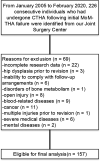Revision of failed metal-on-metal total hip arthroplasty using cemented arthroplasty: a mean 10-year follow-up of 157 consecutive patients
- PMID: 33435780
- PMCID: PMC7809321
- DOI: 10.1177/0300060520969478
Revision of failed metal-on-metal total hip arthroplasty using cemented arthroplasty: a mean 10-year follow-up of 157 consecutive patients
Abstract
Objective: This study was performed to assess the outcomes of Asian patients who underwent conversion from metal-on-metal total hip arthroplasty (MoM-THA) to cemented THA (CTHA).
Methods: One hundred and fifty-seven consecutive patients (157 hips) who underwent CTHA following primary MoM-THA from January 2005 to February 2015 were retrospectively analysed. The primary endpoints were the clinical outcomes. Follow-ups occurred at 3 months, 6 months, 1 year, 2 years, and then every 2 years following revision of MoM-THA.
Results: The mean follow-up after conversion was 10 years (range, 5-14 years). Statistically significant improvements in the mean Harris hip score were observed between the preoperative and final follow-up evaluations (62.71 ± 13.85 vs. 84.03 ± 16.21, respectively). The major orthopaedic complication rate was 16.5% (26/157). Six (3.8%) patients underwent revision at a mean of 3.5 ± 1.3 years after conversion, predominantly because of prosthesis loosening or recurrent dislocation. Nine (5.7%) patients developed prosthesis loosening at a mean of 2.6 ± 1.1 years following conversion, two of whom requested revision surgery. Eleven (7.0%) patients developed prosthesis dislocation, four of whom requested revision surgery.
Conclusion: CTHA may yield favourable functional outcomes and a reduced rate of major orthopaedic complications.
Keywords: Conversion; complication; metal-on-metal; outcome; revision; total hip arthroplasty.
Conflict of interest statement
Figures
Similar articles
-
Mid-term outcomes of uncemented or cemented arthroplasty revision following metal-on-metal total hip arthroplasty failure: a retrospective observational study.J Int Med Res. 2020 Jun;48(6):300060520932051. doi: 10.1177/0300060520932051. J Int Med Res. 2020. PMID: 32600087 Free PMC article.
-
Favourable clinical outcomes following cemented arthroplasty after metal-on-metal total hip replacement: a retrospective study with a mean follow-up of 10 years.BMC Musculoskelet Disord. 2020 Nov 21;21(1):772. doi: 10.1186/s12891-020-03797-y. BMC Musculoskelet Disord. 2020. PMID: 33220707 Free PMC article.
-
Revision of Failed Metal-on-Metal Total Hip Arthroplasty: Midterm Outcomes of 203 Consecutive Cases.J Arthroplasty. 2019 Aug;34(8):1755-1760. doi: 10.1016/j.arth.2019.04.019. Epub 2019 Apr 13. J Arthroplasty. 2019. PMID: 31053470
-
Preoperative Risk Factors Associated With Poor Outcomes of Revision Surgery for "Pseudotumors" in Patients With Metal-on-Metal Hip Arthroplasty.J Arthroplasty. 2016 Dec;31(12):2835-2842. doi: 10.1016/j.arth.2016.05.034. Epub 2016 May 27. J Arthroplasty. 2016. PMID: 27387480
-
Outcomes of different bearings in total hip arthroplasty - implant survival, revision causes, and patient-reported outcome.Dan Med J. 2017 Mar;64(3):B5350. Dan Med J. 2017. PMID: 28260601 Review.
Cited by
-
Long-term Follow-up on Revisions of a Recalled Large Head Metal-on-metal Hip Prosthesis: A Single Surgeon Series.Arthroplast Today. 2023 Jul 23;22:101163. doi: 10.1016/j.artd.2023.101163. eCollection 2023 Aug. Arthroplast Today. 2023. PMID: 37521732 Free PMC article.
References
-
- Lainiala OS, Reito AP, Nieminen JJ, et al. Declining revision burden of metal-on-metal hip arthroplasties. J Arthroplasty 2019; 34: 2058–2064.e1. - PubMed
-
- Crawford DA, Adams JB, Morris MJ, et al. Revision of failed metal-on-metal total hip arthroplasty: midterm outcomes of 203 consecutive cases. J Arthroplasty 2019; 34: 1755–1760. - PubMed
-
- Borton ZM, Mumith AS, Nicholls AJ, et al. The outcome of revision surgery for failed metal-on-metal total hip arthroplasty. J Arthroplasty 2019; 34: 1749–1754. - PubMed
MeSH terms
LinkOut - more resources
Full Text Sources
Other Literature Sources
Medical


